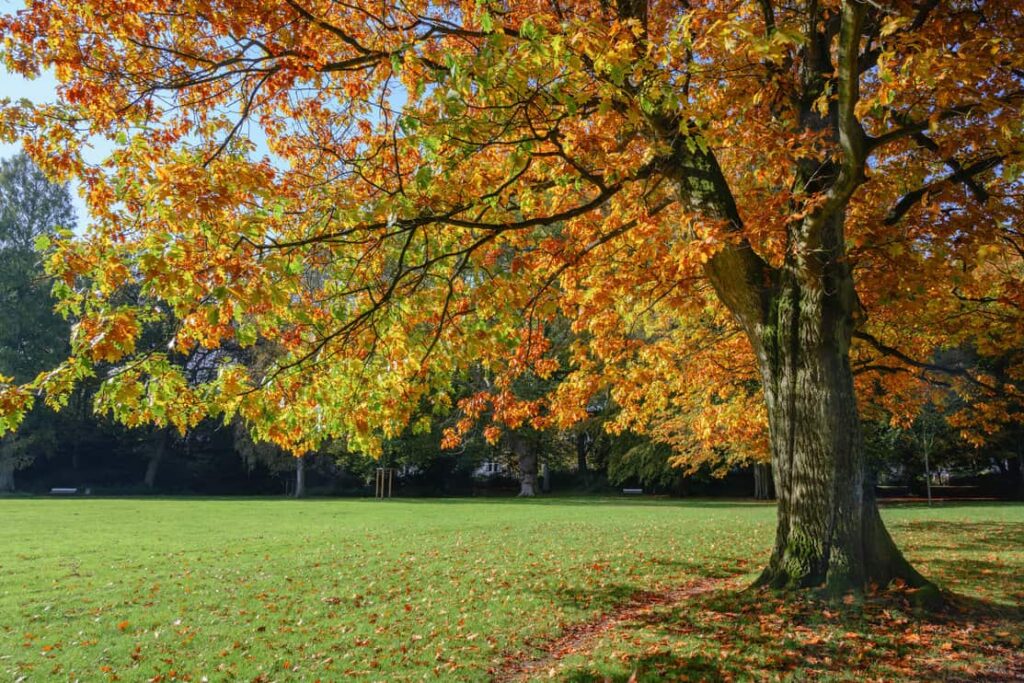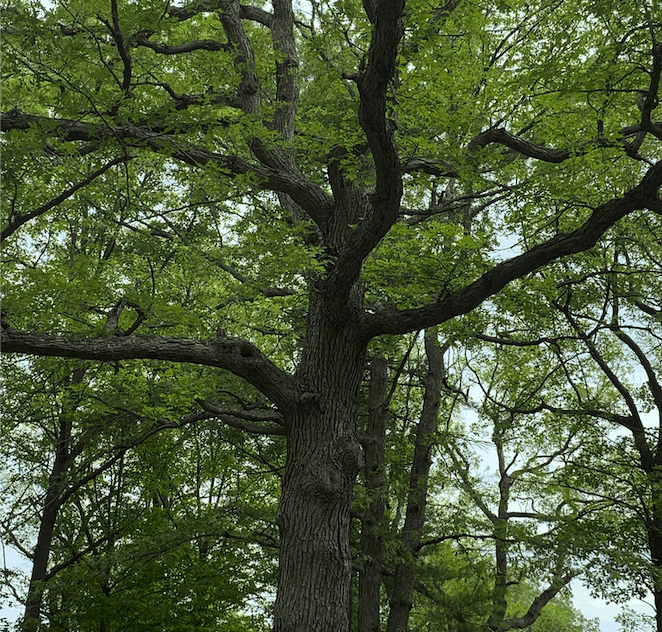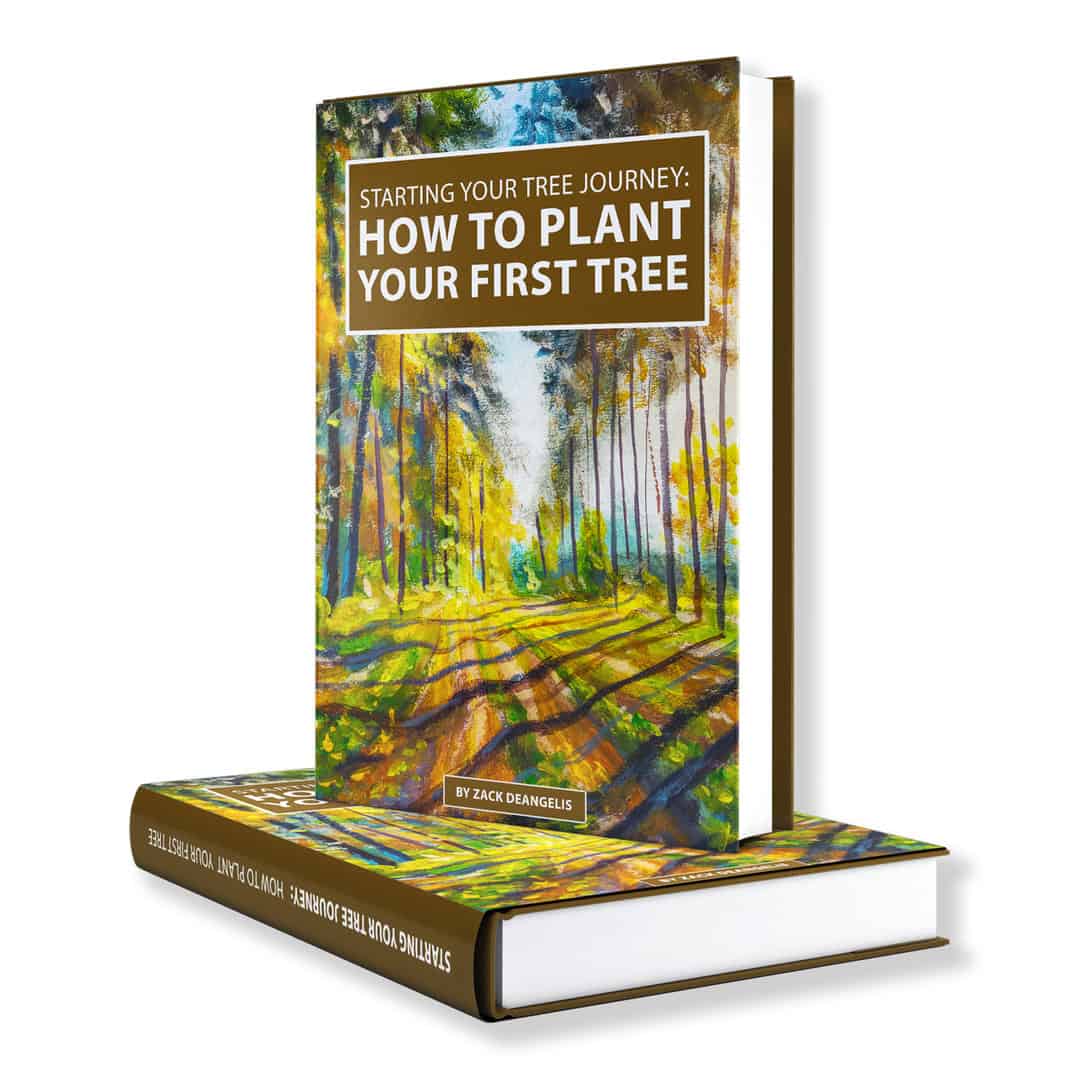9 Best Oak Trees to Plant – Pros and Cons of Major Types

As summertime rolls around and you’re thinking about updating your property, you may be considering planting a new tree that will grow into a cornerstone of your yard. Eventually, you’ll have shade, a place for the kids to climb, and a beautiful little sea of color in the fall. We can picture it now, and hope you can, too!
In general, the best oak trees to plant include willow, black, Japanese evergreen, water, pin, chinkapin, post, bur, and white. These oak trees adapt well to many different habitats and conditions while provide marvelous beauty and shade.
Below, we are going to give you some of the best varieties of oak to plant, complete with a pros and cons list for each. We’ll answer some commonly asked questions that we hear regarding oak trees as well.
What Is An Oak Tree?
So, let’s start simple. What exactly is an oak tree and how is it different from literally any other tree?
An oak tree produces acorns, the fruit that we consider to be a nut. You know, the thing that squirrels love and groundskeepers despise just a little. Its wood is used in creating hardwood floor panels, furniture such as chairs and desks, and cabinets or other storage devices.
There are a wide variety of oak trees, some more adaptable than others and some with better aesthetic qualities. When it comes down to it, though, oak trees are pretty regularly long-lasting, durable, amenable trees.
How Many Varieties of Oak Trees Are There?
We can start by dividing up oak trees into two categories: red oak and white oak.
This helps give us some sort of starting point since there are dozens of varieties of oak trees in North America. Beyond that, the varieties are endless. Between new varieties, hybrids, and mutant varieties of oak, quantifying these trees is easier said than done.
All in all, there are about 500 species of oak trees.
What is the major difference between red and white oaks, you may be asking yourself right about now? The biggest difference is the shape of their respective leaves and the speed at which their acorns develop.
Red Oak Tree

Red oak trees have more of a pointy end on each part of the leaf, very dark bark most of the time, and slower developing acorns.
Some of the most common varieties of red oak are:
- Willow Oak
- Black Oak
- Japanese Evergreen Oak
- Water Oak
- Pin/Nuttall Oak
Keep in mind that these are only a few varieties and if you expected to see one that is not on here, that doesn’t mean that it is not a great variety. We only have so much space and time to talk about a tree that has a huge range of variants spread out across the globe.
White Oak Tree

White oak trees tend to have leaves that are much more rounded, for starters. They also develop their acorns faster than the red oak does. The bark of a white oak has a much more grayish tinge than its red, darker counterpart does.
Some of the most common white oaks include:
- Chinkapin
- Post Oak
- Bur Oak
- White Oak
The differences between red and white oaks are not extremely obvious, but each category and variety of oak has a purpose to serve. In one situation, a red oak might be best. In another situation, a white oak could prevail.
It all comes down to the environment, the need, and the long-term goal for the tree that you are planting.
Luckily for you, we have taken the time to compile a list of the 9 best oak trees to plant, including pros and cons for each so you know that you have made the best choice for your unique situation.
Again, if you aren’t seeing a variety that you were expecting to see, that does not mean that your potential choice is wrong, or that your knowledge of that variety is in vain. With about 500 species of oak, this would be a very long piece if we tried to cover even 10% of the oak tree varieties out there.
If you’re interested, you can read our fancy guide on the main differences between oak and maple trees here.
The 9 Best Oak Trees To Plant
If you’re thinking about planting an oak tree, consider the environment you are planting it in. Is it poorly draining soil or well-draining soil? Are the summers hot? Winters wet?
All of this comes into play when choosing the oak tree that has the best chance of survival in your specific area.
Without further delay, let’s check out the 9 BEST oak trees to plant, and the pros and cons of each.
Willow Oak Tree
The willow oak is characterized by fine twigs and a strong branch structure. It prefers a moist environment but is flexible in the way that most other oaks are, too.
Pros
- Transplants more easily than most other oak varieties
- Tolerates poorly drained soil
Cons
- Produces acorns that may create clutter in your yard
- Requires full, direct sunlight
FYI – the willow oak (Quercus phellos) is different than a typical willow tree, which is from the genus Salix. If you’d like to purchase a willow oak tree, take a look at this fantastic option from Fast-Growing Trees.
Black Oak Tree
Black oak trees, though the name indicates otherwise, are actually part of the red oak category. They’re found in all the coastal regions of North America. This variety also resides a little way inland.
Pros
- The bark has multiple medicinal uses from an astringent to helping with sore throats, fevers, asthma, colds, and so much more.
- Beautiful, vibrant leaves in all seasons
Cons
- Its irregular form means that it might look rather unruly as it grows
- Difficult to transplant, so unlikely to be found in a nursery
Japanese Evergreen Oak Tree
This variety of oak is native to parts of China, Korea, Taiwan, and, of course, Japan. A North American resident since the end of the 19th century, it is an oak tree that is known for the material it produces.
Some Japanese martial arts practice weapons are made out of this Japanese evergreen oak wood. This ties culture, history, and durability all together in a really cool way.
Pros
- Pests are not as likely to attack this tree
- Acts as a great shade cover
- Tolerates soil of many kinds, and is flexible in a range of conditions
Cons
- There is a chance that the tree will be attacked by pathogens such as cankers
Water Oak Tree
Water oak is a variety that holds deep importance when it comes to wildlife and how we utilize oak for our daily needs. Water oaks are used as plywood in produce containers and provide shelter, food, and habitat to the wildlife that roams around it.
Many birds prefer to nest in water oaks, and they also are often home to flying squirrels and other smaller critters.
Pros
- Their acorns provide a source of food to wildlife like squirrels, chipmunks, waterfowl, bluejay, wild turkey, and more.
- Provides lots of shade for your yard
Cons
- Very susceptible to disease and insect attack
- Flowers often do not withstand late frosts
- More susceptible to air pollution than other varieties
Pin/Nuttall Oak Tree
The Nuttall oak is taking over the place of the pin oak, as a very similar but faster-growing, more resilient variety. If you are looking for a long-lasting oak that won’t take decades to mature, this is your guy.
Pros
- Fast growing oak tree
- Thrives in a range of soil conditions
- Requires minimal care
Cons
- Needs at least 6 hours of unfiltered sunlight daily
- Grows large and wide in a quick time, not great for small spaces
- Produces acorns that you may not want falling in your yard
If you’re interested in a Pin Oak, you can grab one here for delivery to your doorstep!
Chinkapin Oak Tree
This oak is a medium-large size and is great for more expansive outdoor spaces. Again, a small backyard might not be the best home for this tree, but it looks amazing and is rather adaptable.
Pros
- Acorns of this variety are a preferred food source for many wildlife and won’t stick around your yard
- Leaves feed cattle, if you are looking for a tree that serves animals, too
- Durable and adaptable variety
Cons
- Too large to thrive in small areas
- Needs direct sunlight and open space
Post Oak Tree
A slow-growing white oak, this tree is more suitable for dry areas due to its resistance to rot, fire, and drought.
Pros
- Fire Resistant
- Drought Resistant
- Rot Resistant
Cons
- Slow-growing
- Susceptible to diseases like cankers and wood-boring insects
Bur Oak Tree
Also spelled burr, at times, this is a beautiful variety of oak that thrives in a wide range of environments from moist woodlands to dry sandhills.
Pros
- Beautiful tree when fully mature
- Tolerant of many soil types
- Long lifespan
Cons
- Produces large acorns that may not be ideal right next to your home
- Large in size and not appropriate for small spaces
White Oak Tree
A tree that thrives best in loamy, well-drained soils, this variety happens to be more durable than the red oak.
Pros
- A type of oak tree that is tolerant of partial to heavy shade, unlike all of the others on this list that need as much direct sunlight as possible
- Acorns provide food for wildlife
- Excellent provider of shade at maturity
Cons
- Young trees hold their leaves through winter and can be a bit aesthetically awkward at the beginning of their lives
- Flowers and acorns can be overwhelming in some years, especially as they fall into your yard
If you’d like to purchase a white oak, you can get one delivered here!
Best Oak Tree Annual Growth, Full Height and Hardiness Zone
Here’s a quick dataset for some of the most popular oak trees, and not just the best ones we discussed on this list. Feel free to search your favorite tree then keep on reading below!
| TREE | ANNUAL GROWTH | FULL HEIGHT | BEST HARDINESS ZONE |
|---|---|---|---|
| Willow oak | 13–24" | 40-60' | 5-9 |
| Japanese evergreen oak | 36" | 30' | 9a-11 |
| Water oak | 24" | 100' | 6-9 |
| Pin oak | 24" | 60-70' | 4-8 |
| Chinkapin oak | 12-24" | 50' | 3-9a |
| Post oak | 2" | 40' | 5-9 |
| Bur oak | 12" | 80' | 2a-8a |
| White oak | 12-18" | 80' | 3b-8b |
| Coast live oak | 24" | 70' | 9-10 |
| Interior live oak | 12-24" | 70' | 8-10 |
| Canyon live oak | 24" | 100' | 8-10 |
| Southern live oak | 24-36" | 50' | 7b-10b |
| Valley oak | 24-36" | 130' | 7-9 |
| Southern red oak | 12-36" | 60-80' | 6-9 |
| Blue oak | 6" | 100' | 5-10 |
| Black oak | 8-12" | 50-60' | 3-9 |
| Laurel oak | 24" | 100' | 6-9 |
| Red oak | 24" | 90-140' | 4-8 |
| Nuttall Oak | 24-36" | 40-60' | 6-9 |
Other Considerations When Planting Oak Trees
There are a few other, more general, rules of thumb that you should keep in mind when planting an oak tree.
You don’t want to be unprepared and later realize that you could have made a simple change early on that would have made everything easier.
So let’s dive into some important factors like time of year, speed of growth, location preferences, benefits of having an oak tree, and even aesthetically pleasing varieties.
When Is The Best Time Of Year To Plant Oak Trees?

Any time of year that the soil is not frozen is a good time to plant an oak tree!
Realistically, late summer or early fall is going to be your best bet. This allows the tree to establish roots in plenty of time before the soil freezes. It won’t do you or your new tree any good if you don’t allow for enough time to settle in before those cold winter months.
If you are looking to transplant an oak tree, it is best to do this in early spring. Perhaps February or March would be ideal but it is really about transplanting just before all of the other flora in your area begins to bud.
Which Oak Tree Grows The Fastest?
In truth, the southern live oak, valley oak, Japanese evergreen and nuttall oak trees are the fastest-growing species of oak and grow 24-36 inches per year.
What Is The Prettiest Oak Tree?
This is quite a subjective question, of course. However, there are three varieties of oak trees that are classically beautiful and tend to be loved by all. They might not all show up on the list of our top 9 oak trees, but these deserve a special mention either way:
- Scarlet Oak Tree– this is an excellent shade tree that is rather attractive to all sorts of wildlife thanks to all its foliage. Its vibrant red leaves in the fall are a wonder to witness and give this tree some serious brownie points in the ‘pretty’ category.
- Red Oak Tree– a highly adaptable variety that combines beauty and stability, as it can live over 500 years (about 200 years longer than many other oaks.) The deep colors of the leaves in any season and the ability to resist disease make this tree great for planting in any setting.
- Bur Oak Tree– with a wide trunk, versatile capacity to handle lots of conditions, and unique leaf shape, this tree is quite a sight. Not only that, this one actually is on our ‘top 9’ list, speaking volumes to its quality and not just its looks.
How Long Do Oak Trees Live?
In general, most oak trees live around 100-150 years! Several species live under this, and there are some very rare exceptions of oak trees that have been alive for thousands of years.
You can read our full guide on how long oak trees live here.
Where Do Oak Trees Grow Best?
Where to grow your oak tree with the most success is dependent on a few factors. Different varieties of oak trees thrive in different environments.
While most are pretty adaptable when it comes to soil, it is worth doing some research into the specific variety that you are hoping to plant.
What Is The Oak Tree Good For?
Oh, you mean besides improving air quality? Well, these trees help reduce pollution in the air through the same process that stores carbon dioxide and puts oxygen back out into the atmosphere.
Oak trees can absorb up to 10 pounds of pollutants a year according to the Napa County Resource Conservation District. Which is a ton when you stop to consider that these trees live around 400 years.
Not only do these trees help purify the air that we breathe, but they also help to enrich the soil in which they grow.
Studies show that they are great catalysts for increased soil fertility through nutrient cycling and incorporation of organic matter.
Now those are some benefits that we can get behind!
That’s All For Now!
So, clearly, we have not been able to list for you every single variety, hybrid, and mutant of the oak tree. Hopefully, however, this gives you a good sense of what to expect when you are planting your oak tree.
Remember, do your research on what type of tree is best suited for your environment, as some varieties of oak are much more resilient and adaptable than others!
From Nuttall oaks to scarlet, red, and bur, there is an oak tree variety out there for everyone! Whether it is strength, speed, looks, or resilience that you are looking for, we know that you will make the right choice when it comes to your newest tree.
Happy planting!
References
Dahlgren, R. A., SINGER, M. J., & Huang, X. (1997). Oak tree and grazing impacts on soil properties and nutrients in a California oak woodland. Biogeochemistry, 39(1), 45-64.
Pilcher, J. R., & Gray, B. (1982). The relationships between oak tree growth and climate in Britain. The journal of ecology, 297-304.
Union of Concerned Scientists. (2010). (Rep.). Union of Concerned Scientists.
Harden, R. M. (2000). Evolution or revolution and the future of medical education: replacing the oak tree. Medical Teacher, 22(5), 435-442.

Download My Free E-Book!
If you’re new to planting or want a refresher, take a peek at my guide on choosing and planting your very first tree. It specifically details planting trees in your yard and goes over the wide variety of options you have to start your #treejourney!






